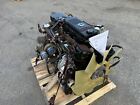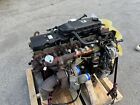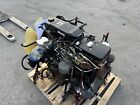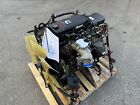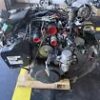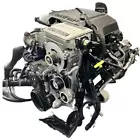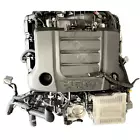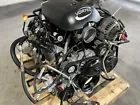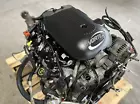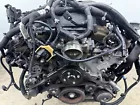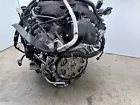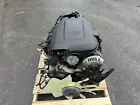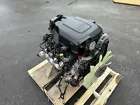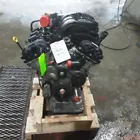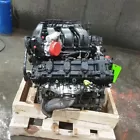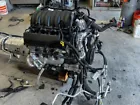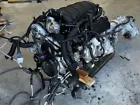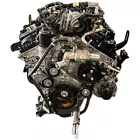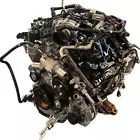DODGE RAM 6.7 CUMMINS ENGINE
4,800 $ Original price was: 4,800 $.4,700 $Current price is: 4,700 $.
here’s an extended, in-depth overview of the DODGE RAM 6.7 CUMMINS ENGINE used in Ram trucks, especially the Dodge Ram 2500, 3500, 4500, and 5500 HD series. This article will cover everything from technical specifications to real-world performance, reliability, applications, known issues, and aftermarket potential.
here’s an extended, in-depth overview of the DODGE RAM 6.7 CUMMINS ENGINE used in Ram trucks, especially the Dodge Ram 2500, 3500, 4500, and 5500 HD series. This article will cover everything from technical specifications to real-world performance, reliability, applications, known issues, and aftermarket potential.
The 6.7L Cummins Engine in Ram Trucks — A Complete Guide
Introduction
The DODGE RAM 6.7 CUMMINS ENGINEl is one of the most iconic engines in the heavy-duty truck market. Manufactured by Cummins Inc., it has been powering Dodge and later Ram trucks since 2007, when it replaced the legendary 5.9L Cummins. This newer engine brought with it significant upgrades in power, torque, emissions compliance, and towing capability, making it a favorite among diesel enthusiasts, fleet operators, and RV owners.
Whether you’re a mechanic, truck owner, diesel performance fan, or just curious about what makes this engine so enduring, this guide will cover all the essential information.
History of the DODGE RAM 6.7 CUMMINS ENGINE
The DODGE RAM 6.7 CUMMINS ENGINE (engine code ISB 6.7) debuted in 2007 as a response to tightening emissions regulations and the need for more torque and modern features. It was the first Cummins engine in a Ram truck to include a diesel particulate filter (DPF), exhaust gas recirculation (EGR), and later, a selective catalytic reduction (SCR) system using diesel exhaust fluid (DEF).
Since its release, the engine has seen multiple updates to improve performance, emissions, fuel economy, and reliability. Each major Ram Heavy Duty truck model year has brought tweaks to this platform, but the base design a robust inline-6 configuration with turbocharging and common rail fuel injection remains a core part of its identity.
Technical Specifications
Engine Configuration
-
Type: Inline 6-cylinder turbo diesel
-
Displacement: 6.7 liters (408 cubic inches)
-
Bore x Stroke: 4.21 in x 4.88 in (107mm x 124mm)
-
Block Material: Cast Iron
-
Head Material: Cast Iron (in some variants, compacted graphite iron)
-
Valvetrain: OHV with 4 valves per cylinder (24 total)
-
Compression Ratio: ~16.2:1 (varies slightly across model years)
-
Aspiration: Turbocharged and intercooled
-
Fuel System: High-pressure common rail direct injection (Bosch system)
-
Turbocharger: Holset Variable Geometry Turbocharger (VGT)
-
Emissions Equipment: DPF, EGR, SCR (DEF) depending on year
Power & Torque Outputs by Model
The DODGE RAM 6.7 CUMMINS ENGINE comes in two main output configurations depending on application:
Standard Output (SO)
-
Horsepower: ~370 hp @ 2,800 RPM
-
Torque: ~850 lb-ft @ 1,700 RPM
-
Used in: Ram 2500, base 3500 models
-
Transmission: 6-speed automatic or manual (G56)
High Output (HO)
-
Horsepower: Up to 420 hp @ 2,800 RPM
-
Torque: Up to 1,075 lb-ft @ 1,800 RPM
-
Used in: Ram 3500/4500/5500 with Aisin 6-speed automatic
-
Transmission: Aisin AS69RC heavy-duty automatic
These numbers vary slightly by year, with more recent models (2023–2025) hitting the upper limits due to ECM tuning, improved airflow, and upgraded turbocharger systems.
Performance and Towing
The biggest reason for choosing a Cummins-powered Ram is towing capacity. The engine delivers massive low-end torque, ideal for hauling trailers, heavy equipment, or fifth wheels.
Towing & Payload (2024 Ram 3500 Example)
-
Max Conventional Towing: ~23,000 lbs
-
Max Fifth-Wheel Towing: ~37,090 lbs (High Output only)
-
Max Payload: ~7,680 lbs
In comparison, gas engines fall far short in these figures, especially for sustained heavy-load hauling over long distances. The inline-6 layout also contributes to smooth, consistent torque delivery, especially important when climbing hills or driving in hot conditions.
Reliability and Longevity
One of the reasons Cummins engines have such a strong following is their reputation for longevity. It’s not uncommon for a well-maintained DODGE RAM 6.7 CUMMINS ENGINE to reach 300,000 to 500,000 miles — and sometimes much more. The heavy-duty cast iron block, forged steel crankshaft, and low-stress inline-6 design contribute to its endurance.
Best Practices for Longevity
-
Use high-quality diesel fuel
-
Stick to a regular maintenance schedule
-
Change fuel and oil filters frequently
-
Allow engine to warm up before towing
-
Use OEM or high-quality aftermarket parts
Emissions and Fuel Economy
Since 2007, the DODGE RAM 6.7 CUMMINS ENGINE has been subject to increasingly strict EPA emissions requirements. It incorporates:
-
Diesel Particulate Filter (DPF)
-
Exhaust Gas Recirculation (EGR)
-
Selective Catalytic Reduction (SCR) using Diesel Exhaust Fluid (DEF)
These systems reduce soot, NOx, and particulate emissions, allowing the truck to be 50-state legal. However, they also increase complexity and maintenance needs.
Fuel Economy
-
Unloaded Highway MPG: 15–22 MPG (varies by truck size and driving habits)
-
Towing MPG: 8–14 MPG
While not as fuel-efficient as smaller diesels, the power and capability balance make it worthwhile for serious towing.
Common Problems and Issues
While the DODGE RAM 6.7 CUMMINS ENGINE is generally reliable, certain issues have been reported over the years:
Known Issues
| Problem | Description | Solution |
|---|---|---|
| EGR Valve Clogging | Soot buildup can cause rough idling, loss of power | Clean or replace EGR; drive more highway miles |
| DPF Regeneration Issues | Short trips can prevent regen cycles | Ensure full regeneration cycles complete; forced regen if needed |
| Turbo Actuator Failure | Electronic actuator wears out | Replace actuator or upgrade to aftermarket unit |
| Fuel Contamination | Water or poor fuel can damage injectors/pump | Use high-quality diesel; consider an aftermarket lift pump |
| Crankcase Ventilation Filter | Clogs over time, increasing crankcase pressure | Replace every 67,500 miles (per Ram maintenance schedule) |
Aftermarket Support and Tuning
The DODGE RAM 6.7 CUMMINS ENGINE is a favorite in the diesel performance world, thanks to its strong internals and massive torque potential. There’s an enormous aftermarket industry for:
-
ECU Tuning & Programmers (EFI Live, MM3, EZ LYNK)
-
Turbo Upgrades
-
Exhaust Systems
-
Intake Kits
-
Lift Pumps (FASS, AirDog)
-
Transmission Upgrades (especially for manual and 68RFE autos)
A properly tuned and built 6.7L can produce 600–900+ horsepower and over 1,500 lb-ft of torque, though this voids warranties and may affect emissions compliance.
Manual vs Automatic Transmission
Early DODGE RAM 6.7 CUMMINS ENGINE models (2007–2018) were available with a 6-speed manual (G56) transmission, which is now discontinued.
-
Manual: More driver control, better for engine braking, but not rated for max towing
-
68RFE Auto: Found in standard Ram 2500/3500 trucks; decent but not ideal for heavy towing
-
Aisin AS69RC Auto: Found in HO Cummins trucks; stronger, more reliable under heavy load
If you plan on extreme towing, the High Output Cummins with the Aisin transmission is the way to go.
Future of the Cummins in Ram Trucks
While Cummins continues to innovate with newer technology (including hydrogen and hybrid concepts), the 6.7L platform remains a core offering in Ram’s HD truck lineup as of 2025. It’s expected to remain in production for several more years, possibly with updates for emissions and fuel economy.
Ram has also started integrating more advanced driver assistance and adaptive cruise control systems with diesel trucks, making them more comfortable and safer for long hauls.
Conclusion
The DODGE RAM 6.7 CUMMINS ENGINE is an icon in the world of heavy-duty trucks. With massive towing capacity, legendary durability, and unmatched aftermarket support, it remains one of the best choices for those who need true diesel power. Whether you’re hauling equipment, towing a fifth wheel, or building a performance rig, the 6.7L Cummins offers unmatched potential in a proven package.
Related products
Engine
Engine
Engine
Engine
Engine
Engine


